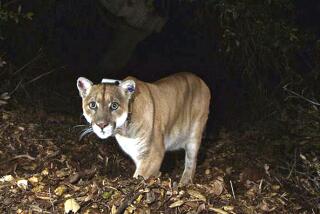Adolescent Cougars Will Be on Prowl in Park, County Reports
By the end of next year, eight or nine mountain lion “teen-agers” will be striking out on their own to stake out their territory near Ronald W. Caspers Wilderness Park, where two children were mauled by the large cats in 1986, according to a newly released county report.
Young cougars stay with their mothers for their first 1 1/2 years, then go out on their own, said Paul Beier, who heads the mountain lion study for the county. It is during the first few months of independence that the young cats are most likely to get into trouble, he said.
The young cats are like “teen-agers,” he said. They are inexperienced and not yet good hunters, so they will sometimes take easy prey, such as dogs and cats--and sometimes even humans.
In his quarterly report, Beier said that by monitoring seven of the adult cats--one male and six females--with radio collars, they have confirmed that seven or eight cougar kittens in three separate litters were born last summer and will be maturing in the next year.
The recent find has prompted Beier to ask the county for an extension of the current two-year study, which is scheduled to end in February.
“We want to get some idea of what these youngsters do and where they go,” Beier said, adding, “I expect one or two of them will get shot for getting into trouble. They’re going to make mistakes.”
When mountain lions mature, the area around Caspers Park in the past has experienced “a marked increase in cougar activity,” Beier said in his report. “And late 1990 and early 1991 promise to present conditions of high cougar density, similar to that which existed in 1986, when the lion attacks occurred.”
In March, 1986, a 5-year-old El Toro girl was severely mauled by a cougar in Caspers Park. Seven months later, in October, a 6-year-old boy was attacked by another mountain lion in the same park. The attacks resulted in a temporary closure of the park and a permanent ban on overnight camping and trail hiking there for children under 18. Initially, adults were required to camp and hike in groups of two or more, but that regulation has been dropped.
Beier said that if one of the young cougars strays into populated areas, he would advocate tranquilizing the animal, then moving it a few miles into the wilderness area.
But he added, “You couldn’t ask an animal control officer not to shoot it a second time” it confronted a human. “Chances are (the lion is) going to run away” from a human, Beier said. But he cautioned, “The worst thing someone can do is run away (from the lion). People need to act aggressively and throw rocks at the lions to scare them away. This makes lions afraid of people, which is good.”
The extended project would cost about $80,000 a year for the next three years, with the bulk of the money going to UC Berkeley, which has been conducting the study for the county. If the extension is approved by the Board of Supervisors early next year, the Orange County Environmental Management Agency will ask the county to pay $60,000 and the state Department of Fish and Game to pick up the additional $20,000 to cover the cost.
More to Read
Sign up for Essential California
The most important California stories and recommendations in your inbox every morning.
You may occasionally receive promotional content from the Los Angeles Times.










